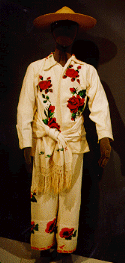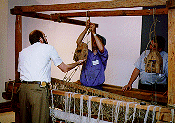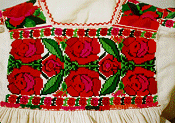|
1900 Nolana |
|
(956) 682-1564 (956) 686-1813 [email protected] |
| New Summer Hours ! Tues, Wed, Fri., Sat: 9:00a. to 7:00p. Thursday: 9:00a. to 8:00p. Sunday: 1:00p. to 5:00p. |
The Weavers Art:
Textiles of Southwest Mexico

- This exhibition celebrates and interprets the age-old weaving traditions of the Amusgo, Huichol, and Tarasco. These Indian groups live in rural communities scattered throughout the states of Michoacan, Jalisco, Nayarit, and Guerrero, all located in southwest Mexico.
- Weaving flourished in Mexico long before the Spaniards arrived in 1519. Today's clothing styles, with their symbolism and social meaning, still retain pre-Hispanic traditions. All the basic parts of an indigenous woman's costume - the huipil (something akin to a blouse), quechquemitl (a diagonally arranged shoulder-covering, wrap skirt, and belt are all pre-Hispanic in origin. Mexican Indian clothing tends to make a strong statement about group identity. Designs, colors, and forms are often distinctive to each village and change only slowly over time. Special costumes for weddings, ceremonies, and use by local officials are often unique to a village.
- Weaving is done mainly by women, but men sometimes get involved, especially if there is a large, heavy floor loom to be worked.
- The Spanish introduced wool, silk, linen, the spinning wheel, and the treadle loom to sixteenth-century Mesoamerica. Cotton was already in widespread use by pre-Hispanic weavers, mainly for clothing the Indian nobility. Tributes, or required gifts, to nobility and later to the Spanish conquistadores usually included woven cloth. Lower classes of people wore clothing made of ixtle, henequen, or other coarse fibers derived from maguey plants. Cotton is still the most widely used fiber for weaving, followed by wool. Silk was used for the postconquest elite but has been largely replaced by rayon and other silk-like materials.
- Although the Spanish also introduced the spinning wheel, Mexico's Indians are more likely to use a spindle whorl for handmade textiles. As they become less geographically isolated they are also more inclined to buy ready-made cotton, which they embroider in their own distinctive style.
-
The basic tool of most weavers is the backstrap loom. The wrap threads on this kind of loom are attached to a post or tree and attached to a strap which fits around the kneeling weaver's back. She must sit on her heels or with her legs outstretched and keep her back straight to keep the warp taught as she runs the weft shuttle through the warp threads. The backstrap loom is easily rolled up and stored when not in use.
 On entering the museum's north Gallery visitors to THE WEAVER'S ART can inspect a venerable old hand-hewn treadle loom which was donated to the museum recently by an Austin collector. It would ave been used for weaving rugs and serapes. (The museum is grateful to local weaver Curtis Whatley for setting it up.)
On entering the museum's north Gallery visitors to THE WEAVER'S ART can inspect a venerable old hand-hewn treadle loom which was donated to the museum recently by an Austin collector. It would ave been used for weaving rugs and serapes. (The museum is grateful to local weaver Curtis Whatley for setting it up.) - The rest of the exhibition is given over to examples of fine weaving and embroidery crafted by the above-mentioned Indian groups. Several styles of huipil are on display, including an especially fine piece with brocaded patterns in pastel colors, unusual in that Mexicans are famous for their love of bright colors. Brocade is distinct from embroidery in that it is worked into a piece as it is being woven, while embroidery is applied when the piece is complete. Each group is represented by a fully clothed model showing how the various garments are worn.
-
The Amusgos, who are concentrated in southeastern Guerrero, have maintained their traditional style of dress since pre-conquest days. A woman's dress consists of a white lacy blouse with embroidery on the edge. her huipil is intricately embroidered with patterns specific to her village. A man's clothing usually consists of long white cotton trousers and a white shirt, more sparsely embroidered than the woman's.
 Huicols, who live in Jalisco and Nayarit, resisted Spanish incursions by retreating into isolated mountain areas, where they have clung to many old customs. However, they seem to have given up hand-weaving more willingly than other groups and the cut of their garments resemble 19th century European styles. However, the lavish embroidery on their clothes refer to ancient symbols and motifs. They favor areas of heavy coverings of cross-stitch and satin stitch, which, when applied to the small bags they carry, gives the impression of tapestry.
Huicols, who live in Jalisco and Nayarit, resisted Spanish incursions by retreating into isolated mountain areas, where they have clung to many old customs. However, they seem to have given up hand-weaving more willingly than other groups and the cut of their garments resemble 19th century European styles. However, the lavish embroidery on their clothes refer to ancient symbols and motifs. They favor areas of heavy coverings of cross-stitch and satin stitch, which, when applied to the small bags they carry, gives the impression of tapestry. - Tarascos dwell in the cool mountain region of northern Michoacan. the women wear a white blouse with embroidery around the neck and sleeves, a full wide skirt made of several yards of dark woolen cloth gathered kilt-style at the back and held in with a sash, a white embroidered apron, and a dark blue shawl, or rebozo, with narrow horizontal white lines. Tarascan men have abandoned their traditional dress in favor of generic campesion style.
- The textiles in THE WEAVER'S ART were collected in Mexico, often from the actual weavers, b the museum's curatorial staff. This exhibition was crated by the museum's curren Curator of Collections, Vernon Weckbacher. it will cointinue in the Main Gallery through December.

